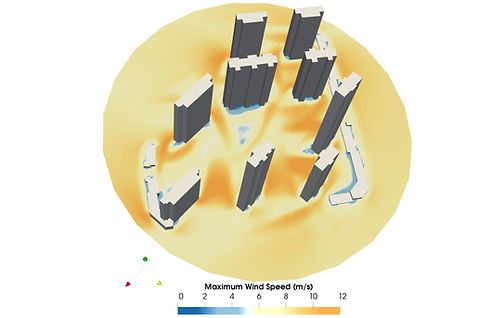Microclimate
Comfort Tool

Radiation Analysis
Traditional early stage studies typically focus on 'snapshot' solar analyses at the equinox or solstices. This is like estimating the annual performance of a building based only on data from the peak day.
Our approach calculates radiation distribution across the site combining hourly data from the weather file and the proposed building massing and landscaping. It takes into account thermal properties of the ground, and impact of surface materials such as grass, stone and water bodies.
This helps calculate the intensity and distribution of direct and diffuse radiation and reflected radiation from the ground, on built surfaces and experienced by people in every part of the area of interest.
Review the annual hourly variation in ground temperature and mean radiant temperature across the site, to identify areas that could benefit from greater or lower exposure and inform the design of local shade and landscape elements.
CFD Analysis
Similar to solar analysis, any Computational Fluid Dynamics (CFD) analysis undertaken for outdoor spaces, is usually limited to particular dates, times and wind speeds, which does not reflect the frequency with which these conditions occur or whether decisions based on these are effective during the rest of the year.
Using cloud based CFD analysis, our tool takes into account the impact of massing on local wind distribution for each hour of the year based on the weather file used. This analysis is run on AWS clusters automatically created behind the scenes and can be monitored from our SketchUp interface.
Demonstrate compliance with wind comfort and safety standards, such as Lawson Comfort Criteria, NEN-8100 Dutch standard or City of London wind microclimate guidelines. Users can compare massing options to identify potential for natural ventilation, evaluate local air quality and identify areas with stagnant air, or excess wind speeds.

Outdoor Thermal Comfort

Pedestrian outdoor comfort depends on a combination of local air speed, radiation on skin, humidity and air temperature. State of the art comfort indices such Physiological Equivalent Temperature (PET) or Universal Thermal Climate Index (UTCI) take these dependencies into account and are well suited to represent actual comfort conditions.
This analysis combines the radiation and CFD analyses described above with environmental variables like air temperature, relative humidity and physiological variables such as metabolic rate and complex clothing models, to evaluate thermal comfort across the area of interest for each hour of the year.
Evaluate comfort using multiple state of the art metrics such as UTCI, PET, or outSET; to show compliance with comfort requirements outlined in the City of London Thermal Comfort Guidelines or Green Mark Technical Guide on Resilience.
This analysis can be undertaken for current and future weather data to future proof public spaces, and ensure that are habitable not only in the short term, but also decades down the line.